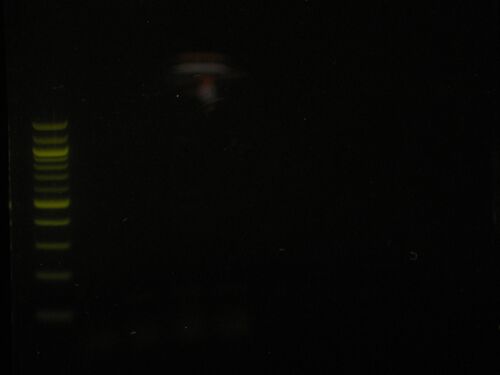User:Anthony Salvagno/Notebook/Research/2010/01/22/Jasper PCR Try 2
Quick Navigation: Pages by Category | List of All Pages | Protocols
PCR Method
The only noticeable change is that I dropped the annealing temp by 2C to 58C. I also decided to do 2 MasterMixes (3 and 5 denoting 5'fluorescent tags).
Results
Preliminary results look negative. Picture to come soon.SJK 20:38, 22 January 2010 (EST)

Is that a 100 bp ladder? If it's 1 kb, then who knows, maybe it's working. For such short products you'll want to run a thicker gel (1.5% I think is what I used) and use 100 bp ladder. It's quite possible your fragment is there, but running off the gel? Hard to say because I don't know your gel conditions. Maybe make a template that allows you to quickly say what kind of gel you're running? (Like you did for excercise last year: {{Gel|p=1.5%|t=90min|v=120}} for exampmle This is really important as far as ONS goes, or even just for communicating between the two of us, since I will think of things sooner (such as gel percentage) if more information is there

So this image looks mighty similar to this mornings. There is a little bit of a smear going on and it seems the electric field is having a parabolic pull on the DNA. Even so, there is nothing going on even if I purify, I doubt I will get anything significant. Maybe I could run another gel with more DNA (this time I used 1ul from my 100ul reaction). I will try this first thing on Monday just in case. Otherwise I'll have to think of alternative reactions.
Future Planning
I will have to talk with Koch about appropriate changes. My first hunch is to do a sweep of divalent cation concentrations ranging from 1 to 5 mM. I would do this with just one set of primers. If that doesn't do anything then I will have to think of different temperatures and times. Maybe melting is not sufficient, or could it be extension? Who knows...
Comments greatly appreciated.
Diego Comments
- The smallest fragment that I've ever amplified was 500 bp, but that's obviously a lot longer than what you have right now.
- My first suggestion would be to make sure that your primers are doing their thing. Have you used them on this template and gotten product before (maybe not this same reaction, but for longer extensions than 100 bp)? Your annealing temperature should reflect the Tm for them, but often times, one or two degrees will make a big difference so I would try a gradient PCR reaction (don't know if you have one of these at the CHTM, but I know that there's one or two of these machines in the Cancer building, ask Kelly about it):
- Same protocol for each step except that in the annealing step, each column should have an annealing temperature that is slightly different. I've used a 10 degree difference before (lowest to highest) so the separation between each was around 0.6 degrees and I was able to get product in one or two of the reactions.
- The 30s of annealing is what I usually do and that works out just fine for me.
- One other thing that I would suggest is running a range of concentrations of template. I usually do reactions with 1x, 0.1x, 0.01x all at the same time and can get product in one of those. I agree that with what Koch suggested since using such small fragments you will probably have to rearrange the concentrations at which your template/primers are at. Remember, you need a molar excess of primers so redo your calculations to make sure that that is still the case in this reaction.
- The last thing that I would check is whether or not your reagents are good or not. I've run into situations where my Taq or my T4 polymerases were being dicks and didn't give me any product. So try running a control reaction that has worked before using those same reagents. Good luck!
- Steve Koch 03:13, 25 January 2010 (EST): Thanks, Diego! In regards to this last point, Ant, you could check whether Taq is being a dick by running a 1.1 kb reaction this morning to see if things are working. While it's running, you could plan something to test the other possibilities, and then run the 100 bp reaction at noon-ish while doing gel for 1.1 kb. I agree that Mg++ is something to explore. As is annealing temperature, which as Diego says would be much easier with a gradient PCR machine. I'd say do what you can in our lab first today (Mg++, maybe other concentrations) before going to Osley lab.